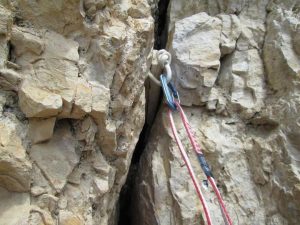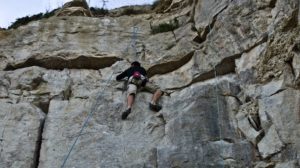Appropriate for almost all ages, indoor climbing improves fitness while building trust, teamwork, and problem solving skills – as well as expanding one’s social network.
Adding indoor climbing to one’s regular workout routine yields an array of benefits for adults and children alike, no matter what fitness level or prior experience they bring to the sport. Benefits of rock climbing include increased physical fitness, improved problem-solving skills, building trust and teamwork, and an expanded social network. Rock climbing indoors is a healthy activity everyone from families to business associates can enjoy together.
Who Can Rock Climb?
A person does not need superhuman strength or massive arms to start climbing. In fact, it’s common to witness a slender, flexible woman out-climbing a burly, toned man. What a person does need to begin rock climbing is to sign up for a beginner climbing lesson at their local indoor climbing gym. The lesson will teach the necessary safety skills for indoor rock climbing.
A Total Body Workout
Nearly every climb will at some point engage almost every part of one’s body, from toes to fingertips. A challenging, all-over body workout demanding coordination, endurance, strength, flexibility, and balance, rock climbing is one of the most calorie-consuming fitness exercises out there. The calories burned while rock climbing rival many more commonly employed workout routines, such as running, cross-country skiing, and bicycling.
An Excellent Exercise in Problem Solving
Unlike so many other workout routines, rock climbing offers the added mental element of continuous problem solving in the midst of a physical workout. Most gyms possess a great variety of injection-molded plastic handholds and footholds. These holds are bolted to the wall in particular sequences, which are marked out as climbing routes. The climber attempts to ascend a selected route without falling.
Building Trust and Teamwork
Rock climbing is one of the best team building activities available for individuals, families, and corporations alike. Participants must learn to work together cooperatively to achieve their individual aims, which they cannot safely achieve alone. Climbing partners literally hold each others’ safety and security in their hands every time they belay.
Expansion of Social Network
Climbing regularly at an indoor gym opens up a new social scene. Since rock climbing safely demands a partnership between climber and belayer, it’s an inherently social endeavor. Climbing partners often discuss “beta” for routes, or the particular way that each believes a certain move or series of moves is most effectively performed. Oftentimes, too, a climber is helped by beta and encouragement shouted from those watching on the ground.
Indoor Climbing for Families and Businesses
Parents looking for active family activities should consider signing their children up for a lesson at an indoor gym — and learning with them. Seeing children as young as six (and sometimes younger) climbing the walls of indoor climbing gyms is not uncommon these days. Climbing gyms often do not allow children under a certain age (often 12) to use the gym without adult supervision.
Businesses can also benefit from using an indoor climbing gym for a corporate outing. Gyms often offer package deals specifically designed for this purpose. The teamwork and team building skills acquired in the informality of the climbing gym environment can potentially translate into a more effective, efficient, and mutually supportive workplace.













